Wildlife Photography In Transition
Author:
First published in Sanctuary Asia,
Vol. 37
No. 10,
October 2017
Involved in fostering a community of photographers and wildlife conservationists, Kalyan Varma is a recipient of numerous awards including the BBC Wildlife Photographer of the Year 2013 in the plants category, best in Animal Behaviour in Poral el Planeta and Sanctuarys Wildlife Photographer of the Year 2005. In our cover story, he describes how what was once the exclusive bastion of a few who loved to be out in the wilds has turned into a difficult to control invasion of fragile wildernesses… and shares what he believes is the future of wildlife photography in India.
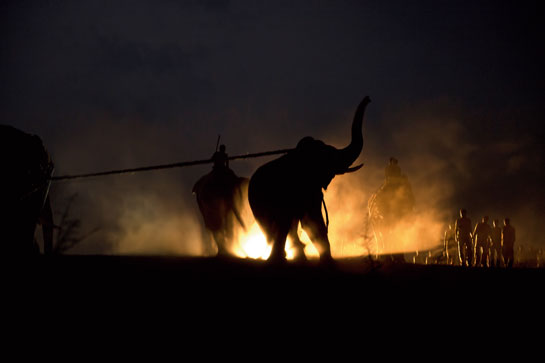 Photo: Kalyan Varma.
Photo: Kalyan Varma.
It was just past five p.m. on a hot June evening in the Ranthambhore National Park. There were more than two dozen gypsies, a preferred wildlife safari vehicle in the Indian jungle, lined up by the edge of the famous Rajbagh lake. Word had got around that the well-known tigress, popularly referred to as Arrow Head, was inside the old fort and would emerge any time now. The sun was slowly descending into the horizon and the evening light had begun to cast long shadows across the landscape.
Suddenly, there was excitement and energy rippling across the vehicles. The atmosphere was charged and all one could hear was the sounds of camera shutters, like the rattling of machine guns in a war zone. It was as if a commander had signalled ‘charge to the platoon waiting to shoot at the slightest movement.
Hundreds of cameras and many expensive ones in their tens of frames per second modes clicked away. The only sounds one could hear was that of cameras going off and within a few seconds the tiger disappeared behind a rock and dozed off lazily. After a pause and deep breath, people began reviewing the images they had managed to shoot and moved on.
I suspect there were at least 2,000 images shot in less than 10 seconds and then, of course, there were a few who had just about managed to take a selfie with the far-away royal Bengal tigress before she disappeared.
In all this commotion, I could not concentrate enough to take a single photograph. Is this what has become of photography? Keep shooting non-stop and hope that you might end up with a good image later?
I realised that it was no longer about an amazing moment in the natural world that people want to capture. Its a paradigm shift in culture and what has become the face of wildlife photography today.
Let me explain.
Until about the 1990s, wildlife photography in India was mostly an exclusive bastion with a few well-known names. Most of them were truly natural history enthusiasts, who mostly chose the medium because of their love for being out in the wild.
As little as 15 years ago, if one had to see and experience nature photographs, most people had to either visit a wildlife exhibition hosted by a well-known photographer in the city or go though second-hand book stores to buy a coffee table book by a foreign photographer.
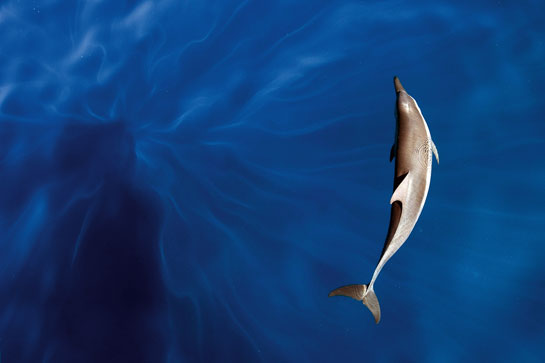 Photo: Kalyan Varma.
Photo: Kalyan Varma.
The last decade
Digital photography technology has grown in leaps and bounds in over just a decade. I remember reading that late legends such as M. Krishnan, T.N.A. Perumal and M.Y. Ghorpade, would spend days and weeks in the wild and come back with just one roll of exposed film. Note that, back then, you could not change the ISO and you were stuck with 36 shots once you had loaded a film. The focal length of lenses was never more than 300 mm. and equally remarkable was the fact that one had to work much harder to access places to find a species of ones interest as well as be a keen naturalist. It wasnt a common skill or hobby.
Today, we have cameras that can even shoot under moonlight. Digital photography has made things so much easier. Not to mention the freedom and ease to process ones images once they are taken. Cameras can focus, expose correctly and take more than 12 images in RAW mode, all in less than a second.
But what has really changed the face of wildlife photography in the last decade are online forums and social media. Thanks to the Internet and forums such as India Nature Watch, people reach out to each other to not only share technical information, but information about natural history and the best places to find a certain species. They link up through networks and social groups and travel together on photography tours.
Today, in the year 2017, more than two billion images are posted online ‘everyday and as per statistics, a person with moderate social media presence, consumes a few hundred images daily. So how can a photographer capture an image that will stand out as ‘one in a billion?
As a photographer, I ask myself this question everyday. Is my photograph good enough in this deluge of images? Am I making meaningful photographs? In this process of questioning myself, I have moved on from defining it from a ‘good image to a ‘successful image.
In todays world, its not the image with the perfect angle and perfect lighting that works, but its the image that makes the most emotional connect with your audience. I have seen images taken with cell phones that are powerful enough for people to notice, remember, stand up and want to act to protect nature or local culture, or just be awestruck by the natural world.
In the quest to do this, I find that photographers have innovated but also have crossed the line of what is ethical and legal.
Historically, information about what to photograph and where was very rare and restricted to a few well-seasoned naturalists and travellers. But with the birth of Internet forums, this kind of information has become easily available, which means a lot more photographers can easily access wildernesses and photograph some of the rarest species in India or even the world.
Many of these photographers are willing to share their images for free on the Internet - as they revel in their passion for wildlife photography, rather than benefit from it financially.
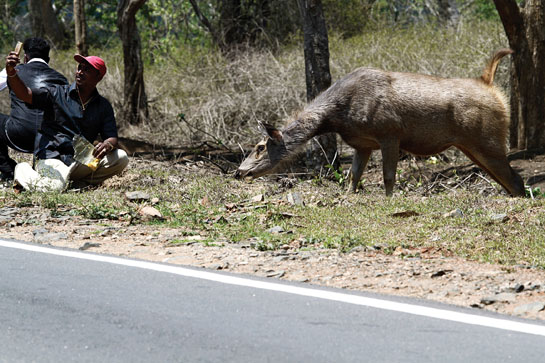 Photo: Muhammed Nizar K.A.
Photo: Muhammed Nizar K.A.
The Ugly Side
However, with the birth of social media, the wildlife photography community has also gone through a drastic change. It is all about how many likes one can get and this has created a sense of competition among photographers. This has also led to many photographers crossing the thin line of wildlife ethics. Some claim to shoot for the love of natural history, but do not hesitate to excessively process the images, which sometimes have no connect with reality. Then there are photographers who will bait or follow unethical methods to get a particular image that is likely to garner more admiration.
As a wildlife photographer, the well-being of the subject must be of utmost importance. This means, not exposing an animal to its prey or obstructing a predator on the hunt. Nature photography at the end of the day is about showcasing the wonders of this natural world and the purpose of it is corrupted if we as photographers disturb the animals to get the shots we want.
The good news is that many organisations are taking a call on ethical photography. Several do not accept nesting bird photographs, as we all know, getting too close to them might reduce their nesting success. The same goes with photographing amphibians and reptiles. They are highly sensitive creatures and taking them out of their natural habitat and bombarding them with heat intense flashes really could affect them in the long term.
Most of my friends who are highly experienced and respected photographers in the industry, take extreme precautions to not disturb the animals or their habitats. But young or amateur photographers, who want overnight success, sometimes cross this line. However, I do believe we must have a clear ethical policy across the board - for example an image of an elephant charging at the photographer according to me is not an ethical image since it is obvious that the elephant was irritated and its comfort zone intruded upon.
There are ethics and there are legal issues. There are certain things that one cannot do legally such as getting out of a vehicle in a park, driving off-road, or catching a wild species. But there are no clear guidelines on where ethics stand. One could even argue that us going into a forest itself is a disturbance for the animals.
So the key is to be constantly aware about these issues and as technology advances, we must keep ourselves updated so we can employ the best techniques and photograph in a way that is least harmful to animals. For example, with the advent of low-light cameras, we really do not need to use powerful flashes that momentarily blind the animals. With long lenses available in the market, one does not have to go close to the subjects either.
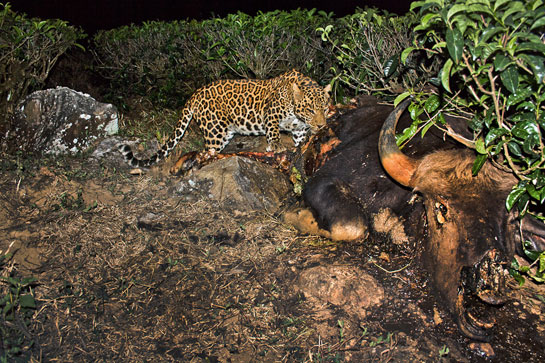 Photo: Kalyan Varma.
Photo: Kalyan Varma.
The future
With the flood of portraits of animals online, photographers have begun pushing new boundaries to document our natural world. Camera traps, once used only by wildlife researchers, are being used by photographers to get intimate views into the lives of secretive animals. This I think is a very non-intrusive way of getting a new perspective on wildlife.
Some have deviated in other directions to create fine-art out of nature. Some of the images that these photographers come out with are pure magic and poetry. With the advent of drones, we can finally get perspective of our landscapes from above which was not possible till now.
But the one thing that no one can deny is that with so many people interested in nature photography, there is a greater interest and awareness about the environmental issues around us. Photographers have not only been documenting species and wild places, but also the damage we do to these landscapes and the conservation issues that we face as we aspire to be a developed country.
People in rural India educate urban folk with their photographs about the real issues that they face when sharing space with nature and we in turn can educate our next generation into appreciating wildlife, who, when they grow up will stand up to save these species and wild places.
The one thing that has bothered me about the wildlife photography scenario in India is the lack of gender diversity. Unfortunately, it continues to be a very male-dominated community and for many, wildlife photography has become a social status. In wildlife conservation and research, where women biologists spend countless weeks and months in the forests, we have a fairly good gender balance, if it can be correctly judged by participation in wildlife and conservation conferences. Why is it that in our wildlife photography community, it is still so skewed? I do not have the answers, but I surely do know for a fact that women bring a certain sensitivity to this art, which men seem less able to accomplish. But times are changing and I believe the next generation of photographers will break from ‘tradition and we will see women come into their own in this fascinating sphere of conservation.
I also sometimes wonder why people come dressed all in camouflage (including their shirts, pants, shoes and even their lenses) and then enter the forest in a colourful and noisy vehicle, which the animals will easily spot. At the end of the day, its the body of work, the way it is done, and the depth of understanding that defines you as a wildlife photographer and not your appearance.
As I look back at that evening in Ranthambhore, I realised I was not going to make an image that would be any different from the thousand others. Instead, I kept my camera aside and enjoyed the view of the tiger through my binoculars. I watched and appreciated the excitement of others at seeing a tiger, and, thought… maybe I will get another day when I will be able to make an image that I will be happy about and maybe that will be ‘successful in this crowded world.
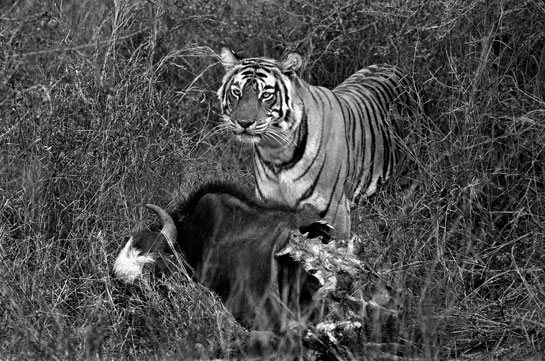 Photo: T.N.A. Perumal.
Photo: T.N.A. Perumal.
Wildlife Photography In India “In the early 1900s, it was the ‘in-thing; a matter of pride and prestige, to hunt with a gun. Fortunately, enlightened persons discarded the gun in favour of the camera when they discovered that photography was a far better sport, demanding even greater stealth and skill, better knowledge of animals, in addition to a keenly developed sense of aesthetics. The fact that animals shot with the camera were free to roam the jungles greatly added to the magnetic draw for this new activity. Photographs had other advantages over blood sports. The images were more permanent and, what is more, such ‘trophies could easily be duplicated and then shared with friends! Many of our pioneer wildlife photographers were ‘hunters turned photographers. We owe much to F.W. Champion, Col. Jim Corbett, Col. Bates, Phillips, E.N.H. Lowther, Loke Wan Tho, Dr. Salim Ali, E.P. Gee, O.C. Edwards and even M. Krishnan who is one of Indias leading wildlife photographers today. Most of these stalwarts set an example for us by producing masterpieces in the face of tremendous handicaps - mainly heavy, slow equipment and limited photographic materials. In my opinion, F.W. Champion still has no parallel, his photographs of tigers and leopards obtained with trip-wire and powder-flash being virtually unbeatable. Though these photographers were all of different temperaments and from different walks of life, what was common to them was the spirit of adventure, perfection, patience, dedication to the study of animals and a love for the outdoors. Their passionate concern for wildlife and devotion to their craft and natural history is evident in their inspiring photographs and literature. These are the qualities required in the making of a wildlife photographer. We are fortunate indeed to have inherited this legacy of good photography from our pioneers. … I feel that the main motivation for being in jungles with our cameras is to be one with nature, far from the maddening rat-race, pollution and cacophony of modern life, and to renew our spiritual relationship with our beautiful forests and animals - the ‘beautiful people. Let us enjoy their company and not disturb them unduly in our over-enthusiasm to get ‘great pictures. Let us make it a sport and not introduce unwanted pressures, interferences and thrust unnatural ‘conditioning on animals that may unduly modify their normal lives. Let our tribe of wildlife photographers increase; more wildlife and camera enthusiasts would mean more concerned people championing the cause of wildlife preservation. It will also augur well for the safe future of our sanctuaries and national parks. Perhaps, for the future welfare of man himself."
Excerpts from Wildlife Photography in India, Problems and Prospects By T.N.A. Perumal, VOL. X. No. 3. May/June 1990 |
First appeared in: Sanctuary Asia, Vol. XXXVII No. 10, October 2017.


 Photo: Kalyan Varma.
Photo: Kalyan Varma.  Photo: Kalyan Varma.
Photo: Kalyan Varma.  Photo: Muhammed Nizar K.A.
Photo: Muhammed Nizar K.A.  Photo: Kalyan Varma.
Photo: Kalyan Varma.  Photo: T.N.A. Perumal.
Photo: T.N.A. Perumal.